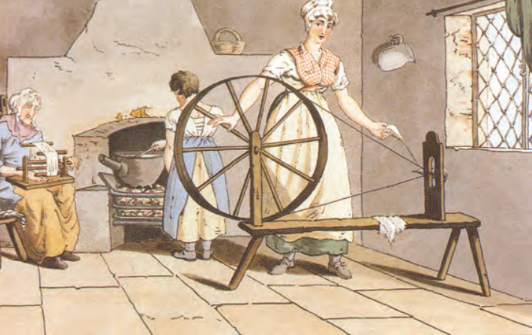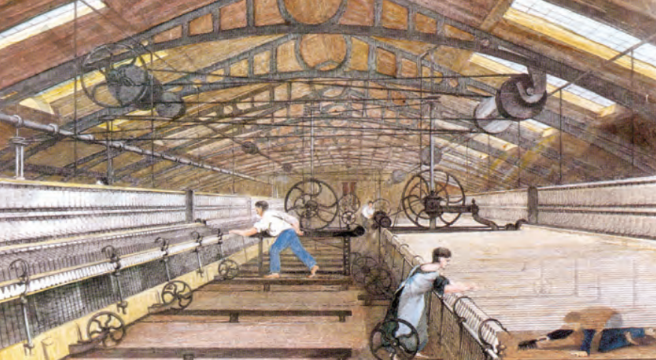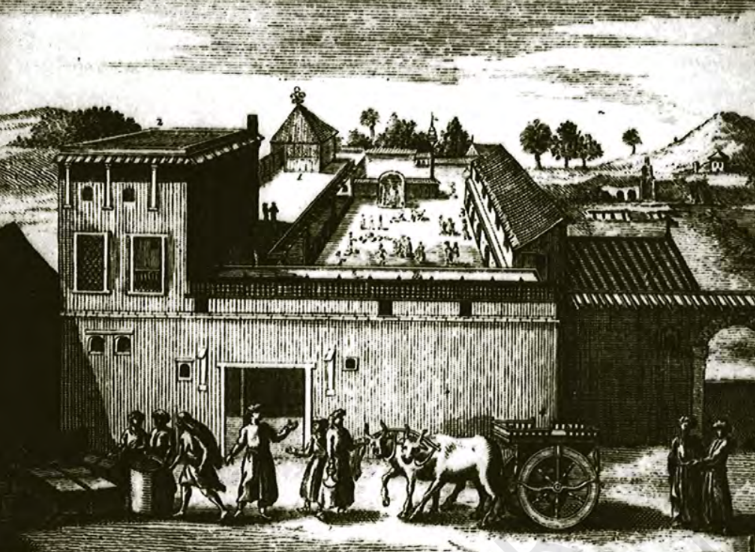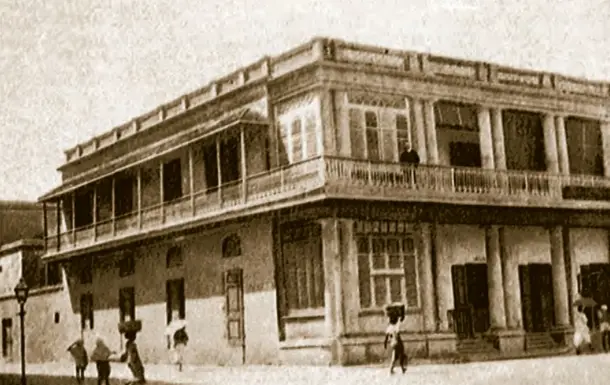Tag: the age of industrialisation notes class 10
The Age of Industrialization Class 10 Notes: NCERT History Ch. 4
The Age of Industrialization Class 10 Notes: Chapter 4 of CBSE Class 10 delves into the historical narrative of two pivotal entities. It initiates with the chronicles of Britain, the pioneering industrial nation, followed by an exploration of India, where the trajectory of industrial transformation was profoundly influenced by colonial dominion.
The chapter commences by elucidating the pre-Industrial Revolution landscape and its gradual metamorphosis, encompassing aspects like labor dynamics and the establishment of factories.
Within the chapter, various themes are expounded upon, including the industrialization of colonies, the trajectory of industrial growth, the emergence of consumer markets, and the intricate tapestry of workers’ lives.
This article presents a compilation of comprehensive CBSE Class 10 History notes specifically addressing Chapter 4 – The Age of Industrialization. These notes encompass all indispensable concepts discussed within the chapter, catering to the holistic understanding of students. For the convenience of learners, these notes are also accessible for download in PDF format.
The Age of Industrialization Class 10 Notes: NCERT History Chapter 4

The Age of Industrialization Class 10 Notes: NCERT History Ch. 4
Before the Industrial Revolution
Proto-industrialization denotes a precursor phase predating the establishment of factories in both England and Europe. During this era, extensive industrial production occurred on a large scale for the global market, operating independently of factory-based systems.
In the seventeenth and eighteenth centuries, European merchants migrated to rural areas, infusing capital into the hands of peasants and skilled craftsmen, urging them to create goods for the international market.
The expansion of production within urban centers was curtailed by regulations that bestowed exclusive production and trade rights upon distinct guilds, limiting merchants’ growth potential.
In the rural expanse, impoverished peasants and artisans readily embraced this arrangement, enabling them to sustain their rural livelihoods and tend to their modest plots of land. Consequently, the Proto-industrial framework seamlessly integrated into a web of commercial interactions orchestrated by merchants at the helm.

The Coming Up of the Factory
During the 1730s, the initial establishments of factories emerged in England; however, it was not until the latter part of the eighteenth century that their proliferation took place. The emergence of a substantial number of factories occurred during this period. A transformative emblem of this era was cotton, which experienced a remarkable surge in production during the late nineteenth century.
Richard Arkwright played a pivotal role in this industrial shift by introducing the concept of the cotton mill. These mills encompassed a synthesis of expensive machinery and harmonized multiple processes within a single premises, all managed under a unified framework.
The Pace of Industrial Change
Firstly, in Britain, the most vibrant sectors during the initial phase of industrialization were textiles, particularly cotton, and the metallurgical domain. The ascendancy of cotton prevailed in the first stage of industrialization, extending until the 1840s, succeeded by the rise of the iron and steel industry.
Secondly, the advent of novel industries encountered challenges when attempting to supplant well-established traditional counterparts.
Thirdly, the momentum of transformation within the conventional industries wasn’t solely dictated by the steam-powered cotton or metal sectors. While these traditional industries didn’t remain entirely stagnant, their evolution was not solely driven by the rapid progress of the steam-powered sectors.
Fourthly, technological advancements manifested at a deliberate pace. Notably, James Watt enhanced the Newcomen steam engine, securing a patent for his improved design in 1781. His associate, the industrialist Mathew Boulton, assumed the role of manufacturing the innovative model. However, the integration of steam engines into other industries transpired much later in the century.

The Age of Industrialization Class 10 Notes:
Hand Labour and Steam Power
Human labor was abundant during the Victorian era in Britain. The scarcity of labor or elevated wage expenses wasn’t a concern for industrialists. Contrary to a deficiency of machinery, what industrialists truly necessitated was substantial capital investment. Numerous industries exhibited a seasonal pattern in their demand for labor. In these sectors characterized by fluctuating production tied to specific seasons, manual labor remained the preferred choice for industrialists, who engaged workers for the corresponding period.
Life of the Workers
The prevalence of an abundant labor pool in the market significantly influenced the lives of workers. Securing employment required workers to possess pre-existing networks of friendship and family ties within a factory. Until the mid-nineteenth century, job prospects for workers were notably challenging to come by. However, in the early nineteenth century, there was an augmentation of wages.
The apprehension of unemployment fostered a sense of resistance among workers towards the implementation of novel technologies. One such instance was the introduction of the Spinning Jenny in the woollen industry. Following the 1840s, urban areas witnessed heightened construction activity, thereby creating more extensive avenues for employment.
This period saw the expansion of roads, the establishment of new railway stations, extensions of railway lines, the excavation of tunnels, the implementation of drainage and sewer systems, and the construction of embankments along rivers.
Industrialisation in the Colonies
The Age of Indian Textiles
In the pre-era of mechanical industries, the global textile market was primarily led by silk and cotton goods in India. A diverse array of Indian merchants and financiers played integral roles within this intricate export trade network, which encompassed activities such as financing production, transportation of goods, and provisioning for exporters.
However, the ascendancy of this network, overseen by Indian merchants, commenced waning by the 1750s. During this time, European companies began asserting dominance, initially acquiring a range of concessions from local courts and eventually securing exclusive trading rights.
The transition from established ports to newly established ones symbolized the burgeoning influence of colonial powers. European trading companies orchestrated trade operations through these new ports, facilitated by European vessels. Consequently, several longstanding trading enterprises faced decline, compelling those wishing to endure to function within a framework shaped by the operations of European trading entities.

What Happened to Weavers?
Post the 1760s, the consolidation of the East India Company initially did not result in a decline of textile exports originating from India. Prior to establishing political dominance in Bengal and Carnatic during the 1760s and 1770s, the East India Company grappled with ensuring a consistent supply of exportable goods. However, upon solidifying political control, the East India Company engineered a comprehensive management and regulatory framework aimed at eradicating competition, managing costs, and ensuring steady provisioning of cotton and silk products. This systematic approach was implemented through a sequence of measures.
Firstly, existing intermediaries and brokers associated with the textile trade were systematically phased out, allowing for more direct oversight over the weavers.
Secondly, the Company imposed restrictions on its own weavers, barring them from engaging with other potential buyers.
Additionally, weavers were offered loans for the purchase of raw materials upon order placement. The resulting cloth was handed over to a “gomastha,” acting as an intermediary. Weaving involved the collective effort of entire families, with men, women, and children contributing to distinct stages of the process. Previously, merchants maintaining close ties with weavers played a pivotal role. However, the new “gomasthas” were outsiders without any social connection to the village.
In several regions of Carnatic and Bengal, weavers established looms in villages where familial ties existed. Conversely, in other locales, weavers, together with village traders, initiated revolts, protesting against the East India Company and its officials. Over time, many weavers began declining loans, leading to the cessation of their workshops and a transition to agricultural labor. By the onset of the nineteenth century, cotton weavers encountered an array of fresh challenges.
Manchester Comes to India
In 1772, Henry Patullo asserted that the demand for Indian textiles would remain steadfast, given that no other nation matched the caliber of its goods. Regrettably, by the early nineteenth century, India experienced a decline in its textile exports. During this period, the export of British cotton goods to India underwent a remarkable surge. Towards the close of the eighteenth century, the import of cotton piece goods became constrained within India. Within the Indian context, cotton weavers confronted dual challenges:
1. The collapse of their export market.
2. A contraction and saturation of the local market due to inflows of imports from Manchester.
As the 1860s dawned, weavers encountered yet another predicament – an insufficient supply of good-quality raw cotton. Paradoxically, despite an escalation in raw cotton exports from India, prices soared. By the conclusion of the nineteenth century, a fresh predicament emerged for other artisans as well. The advent of Indian factories led to an inundation of the market with machine-produced goods.
Factories Come Up
In 1854, the inaugural cotton mill was established in Bombay, commencing production after a span of two years. Subsequently, by 1862, an additional four mills were established, coinciding with the emergence of jute mills in Bengal.
The inception of the first jute mill dates back to 1855, with another establishment emerging seven years later in 1862. Concurrently, during the 1860s, the Elgin Mill initiated operations in Kanpur, situated in northern India, while the subsequent year marked the establishment of the foremost cotton mill in Ahmedabad.
The timeline progressed, culminating in 1874, when Madras welcomed the commencement of production in its premier spinning and weaving mill.
The Early Entrepreneurs
The origins of commerce trace back to the late eighteenth century, marked by British exports of opium to China and the transportation of tea from China to England. Certain enterprising individuals participating in these trade activities harbored ambitions of nurturing industrial endeavors within India.
In Bengal, Dwarkanath Tagore amassed wealth through China-related trade, while in Bombay, Parsi figures like Dinshaw Petit and Jamsetjee Nusserwanjee Tata erected substantial industrial dynasties across the Indian landscape. The enterprising Marwari entrepreneur Seth Hukumchand pioneered India’s inaugural jute mill in Calcutta during 1917, marking a pivotal moment in industrial history.
This landscape of opportunity in the industrial realm unfolded alongside a colonial backdrop, wherein Indians were precluded from direct trade in European-manufactured goods.
Consequently, their exports predominantly comprised raw materials and agricultural staples – encompassing raw cotton, opium, wheat, and indigo – items in demand by the British. Among the influential European Managing Agencies were Bird Heiglers & Co., Andrew Yule, and Jardine Skinner & Co. These entities mobilized capital, facilitated the establishment of joint-stock companies, and undertook their management, thereby shaping the economic landscape.
Where Did the Workers Come From?
With the burgeoning expansion of factories, the need for a larger workforce surged. Many laborers originated from nearby districts, driven by the pursuit of employment opportunities. In fact, a notable instance from 1911 reveals that over half of the workforce in Bombay’s cotton industries hailed from the neighboring Ratnagiri district.
Similarly, the mills in Kanpur predominantly sourced their textile labor from the surrounding villages within the Kanpur district. The prospect of employment acted as a powerful magnet, compelling workers to undertake significant journeys in the aspiration of securing positions within the mills.
Despite the escalating demand for labor, job acquisition remained a formidable challenge. The number of job-seekers consistently exceeded the available positions. To navigate this scenario, a substantial portion of industrialists enlisted the assistance of a “jobber,” who often hailed from the same village.
These jobbers were entrusted with the task of recruiting new workers. Industrialists supported these jobbers in establishing themselves and provided them with financial aid when necessary.
The Peculiarities of Industrial Growth
The European Managing Agencies exhibited a keen interest in specific commodities like tea and coffee. They established plantations for these beverages and invested in mining, indigo, and jute. However, these products were primarily earmarked for exports. As the late nineteenth century unfolded, Indian entrepreneurs initiated the establishment of industries. The yarn manufactured in Indian spinning mills found utilization among domestic handloom weavers or was exported to China.
The trajectory of industrialization was marked by a series of transformative shifts. The Swadeshi movement, garnering significant support, led nationalists to boycott foreign textiles. Beginning in 1906, Indian yarn exports to China underwent a decline due to the influx of products from Chinese and Japanese mills inundating the Chinese market. Until the conclusion of the First World War, the pace of industrial growth remained sluggish.
The war’s arrival precipitated a complete upheaval, profoundly altering the landscape. Indian mills seized the opportunity, catering to wartime demands by supplying essential items like jute bags, cloth for military uniforms, tents, leather boots, and an array of other requisites such as horse and mule saddles. Industrial production surged dramatically during this period. In the aftermath of the war, Manchester struggled to regain its former prominence within the Indian market as the industrial boom continued to shape the landscape.

Small-Scale Industries Predominate
Throughout the rest of the country, small-scale industries remained dominant. A minor fraction of the entire industrial workforce was employed within registered factories, while the majority engaged in small workshops and domestic units.
Handicraft production experienced growth during the twentieth century, especially within the realm of handloom cloth production. This expansion was facilitated by the adoption of new technologies, allowing for increased production without causing an undue escalation in costs.
Certain segments of weavers were better positioned than others to navigate competition from mill industries. Some specialized in crafting coarse cloth, while others focused on weaving finer variants. It’s worth noting that those weavers and artisans who persisted in expanding their production during the twentieth century didn’t necessarily thrive.
Their toil extended over long hours, involving the labor of women and children as well. Despite these challenges, they weren’t mere vestiges of a bygone era in the age of factories. On the contrary, their livelihoods and contributions were intrinsic to the very process of industrialization.
Market for Goods
Advertisements serve as influential tools in fostering the allure and perceived necessity of newly introduced products. Their role extends to shaping perceptions, instilling desires, and kindling fresh needs within people.
The contemporary landscape is saturated with advertisements that span various mediums – newspapers, magazines, billboards, urban walls, and television screens. This practice of advertising has been integral since the inception of the industrial era, contributing to the expansion of product markets and the cultivation of a novel consumer ethos.
Pioneering industrialists in Manchester introduced labels affixed to cloth bundles, delineating their quality. The sight of a conspicuous ‘MADE IN MANCHESTER’ inscription on these labels aimed to instill buyer confidence in purchasing the fabric. Several labels incorporated intricate images, showcasing artistic craftsmanship.
Intriguingly, these labels featured depictions of Indian deities, thereby forging a connection with cultural symbolism. Manufacturers introduced printed calendars as a means to popularize their merchandise, adorning them with divine figures to enhance product appeal. Over time, the realm of advertising evolved to serve as a conduit for the Swadeshi movement’s nationalist narrative.
Conclusion
The era of industrialization has ushered in significant technological advancements, the proliferation of factories, and the formation of a distinct industrial workforce. Amidst this transformation, traditional craftsmanship and small-scale production have retained their significance within the industrial milieu.
Read Also:
- The Rise of Nationalism in Europe
- Nationalism in India
- Print Culture and The Modern World
- The Making of a Global World
Frequently Asked Questions on The Age of Industrialization Class 10 Notes
Q 1: What were the main points of the age of industrialisation?
The onset of modernization was initiated by the era of industrialization in Europe. Rapid establishment of factories facilitated extensive production of goods, culminating in global trade networks. The impetus for this transformation was further amplified by novel inventions and technological innovations. Concurrently, European powers extended their colonial domains, thereby extending the reach of modernization to these territories.
Q 2: What is the importance of industrialisation Class 10?
Industrialization plays a pivotal role in eliminating unemployment and poverty. The establishment of numerous factories within a region generates a substantial demand for a workforce. Moreover, industries contribute to the growth and evolution of urban centers. The ripple effects of industrialization extend to fostering economic advancement and the overall development of a nation.
Q 3: What are the advantages and disadvantages of Industrialisation?
Advantages of industrialization include increased economic growth, job opportunities, technological advancements, improved infrastructure, and enhanced productivity. It leads to higher standards of living and innovation.
However, industrialization can also contribute to environmental degradation, resource depletion, income inequality, and health risks due to pollution and hazardous working conditions. The rapid pace of change may lead to social disruption and cultural shifts, while overreliance on certain industries can make economies vulnerable to market fluctuations.
Striking a balance between progress and sustainability becomes crucial in managing the potential drawbacks of industrialization.